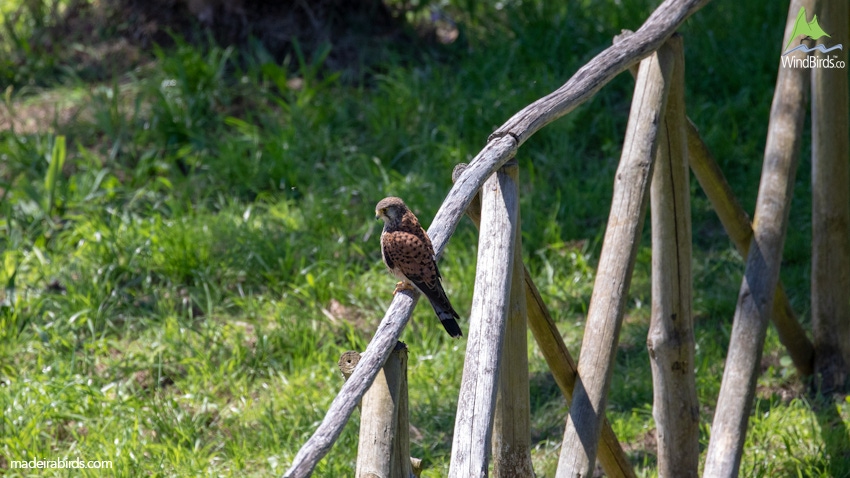Canarian Kestrel Falco tinnunculus canariensis (Koenig, 1890)
Order: Falconiformes Family: Falconidae Status: Breeding in Madeira

Recommended birdwatching tours to watch this bird
Half-day birdwatching
Full-day birdwatching
Canarian Kestrel Field ID Keys
Shape & Size
The smallest bird of prey breeding in the archipelago with a short, round head, fairly long tail and pointed wings.
Colour Pattern
This species shows marked sexual dimorphism, with the female having brown upper-parts with dark streaks on the head and tail while the male has a greyish head and tail. Both sexes have a brown, speckled chest, pointed wings with dark tips and a dark streak under the eyes. As a Macaronesian subspecies it is darker, more rufous brown than the Eurasian kestrel.
Behavior
This bird of prey is able to hover for long periods, soaring with wings and tail fanned. Its flight is direct with fast, shallow wingbeats interspersed with glides.
Habitat
It is found in a wide variety of habitats, such as indigenous and exotic forest areas, areas with creeping vegetation, open cultivated areas, inland and coastal cliffs and even on the outskirts of urban centres.
The Canarian Kestrel is widely distributed in Madeira, being found close to the sea and right up to the mountain summits. In recent years it has only been found on the islands of Madeira and Porto Santo, although in the past Kestrels nested on the Desertas and Selvagens islands.
Distinction from similar species
It can be easily confused with the Common Kestrel though the canariensis subspecies is slightly smaller and darker brown on its back than its congener.
Lesser Kestrel, an uncommon vagrant to Madeira can also seem similar with main differences being its smaller size (5 to 10 cm smaller than Common Kestrel), pale underwings and unspotted back on males.
Falco tinnunculus Biometrics
Wingspan: 60 - 75 cm (Beaman & Madge, 2011)
Total length: 30 - 34 cm (Beaman & Madge, 2011)
Weight: 190 - 300 g (Hume, 2002)
Other Bird Facts
Seasonality in Madeira: All year
Breeding: Nests on rock ledges or in holes on rocky precipices. Birds living near the coast sometimes nest in tall palm trees. The nesting season starts in April with a single set of three to seven eggs being laid in May/June and ends in July when the young birds become independent.
Diet: In Madeira they mainly feed on Madeira Wall Lizards Teira dugesii, though they can also eat mice and earthworms.
Status
Madeira local status by Correia-Fagundes et al, 2021: Common breeding bird
Madeira local status by Romano et al, 2010: Common breeding bird
Madeira local status by Zino et al, 1995: Very Common breeding bird
Conservation status by the IUCN Red List Categories, 2013: Least Concern ver 3.1
Name of this species in other languages
Madeiran: Francelho
Portuguese: Peneireiro
German: Turmfalke-canariensis
Dutch: Torenvalk
Swedish: Tornfalk
Danish: Tårnfalk
Finish: Tuulihaukka
Norwegian: Tårnfalk
Spanish: Cernicalo Canario
French: Faucon crécerelle
Italian: Gheppio canario
Polish: Pustulka zwyczajna
Slovak: Sokol kanársky
Czech: Poštolka obecná
English synonyms: Kestrel